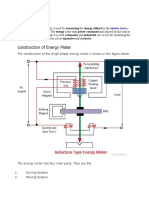Power System Analysis
Uploaded by
nnkhanhvanPower System Analysis
Uploaded by
nnkhanhvanECE 476 Power System Analysis Fall 2014
Homework 1
Reading: Chapters 1 and 2 of GS&O
Problem 1. With |V | = 100 V, the instantaneous power p(t) into a network N has a maximum value
1707 W and a minimum value of -293 W.
1. Find a possible series RL circuit equivalent to N.
Dene v(t) and i(t) of the network N as
v(t) =
2V cos(t +
V
),
i(t) =
2I cos(t +
I
).
Then, the instantaneous power into N is
p(t) = v(t)i(t) = 2V I cos(t +
V
) cos(t +
I
)
= V I [cos(
V
I
) + cos(2t +
V
+
I
)] .
The maximum value of p(t) occurs when cos(2t +
V
+
I
) = 1 and, similarly, the minimum value
of p(t) occurs when cos(2t +
V
+
I
) = 1. So we have the following 2 equations:
P
max
= V I cos(
V
I
) + V I = 1707 W
P
min
= V I cos(
V
I
) V I = 293 W
Subtracting one from the other, we get
2V I = 1707 + 293 = V I = 1000 W = I = 10 A,
and adding the two and substituting V I = 1000 in, we get
2V I cos(
V
I
) = 2000 cos(
V
I
) = 1414 =
V
I
= cos
1
1414
2000
= 45
.
An inductive load causes current to lag the voltage, so we get
V
I
= 45
. Now we use V = 100
V
and I = 10
I
to get
Z =
V
I
=
100
V
10
I
= 10(
V
I
) = 1045
.
Finally we obtain R = R(Z) = 7.07 and L = I(Z) = 7.07 = L = 0.0188 H.
2. Find S = P + jQ into N.
Using the voltage and current phasors from above, we get
S = V I
= (100
V
)(10
I
)
= (100
V
)(10(
I
)) = 1000(
V
I
) = 100045
.
So S = P + jQ, where P = R(S) = 707 W and Q = I(S) = 707 Var.
1
3. Find the maximum instantaneous power into L and compare with Q.
The instantaneous power into L is
p
L
(t) = v
L
(t)i(t) = L
di
dt
i(t) = L
2I sin(t +
I
)
2I cos(t +
I
)
= 2LI
2
sin(t +
I
) cos(t +
I
)
= LI
2
sin(2t + 2
I
).
The maximum value of p
L
(t) occurs when sin(2t + 2
I
) = 1, and at this point,
p
L,max
= LI
2
= 260(0.0188)(10
2
) = 707 W,
which is equal to Q.
Problem 2. A certain 1 load draws 5 MW at 0.7 power factor lagging. Determine the reactive power
required from a parallel capacitor to bring the power factor of the parallel combination up to 0.9.
With the current power factor of 0.7 lagging, we solve the following for the current Q:
tan(cos
1
(0.7)) =
Q
cur
P
=
Q
cur
5
= Q
cur
= 5.101 MVar
To reach a power factor of 0.9 lagging, we solve the following for the desired Q:
tan(cos
1
(0.9)) =
Q
des
P
=
Q
des
5
= Q
des
= 2.422 MVar
Therefore, the reactive power required from a parallel capacitor to bring the power factor to 0.9 is
Q
cap
= Q
cur
Q
des
= 5.101 2.422 = 2.679 MVar
Problem 3. A 3 load draws 200 kW at a PF of 0.707 lagging from a 440-V line. In parallel is a 3
capacitor bank that supplies 50 kVAr. Find the resultant power factor and current (magnitude) into the
parallel combination.
In each phase, the load draws 200/3 kW at a PF of 0.707 lagging. So we solve for the reactive power
that the load draws in each phase as follows:
tan(cos
1
(0.0707)) =
Q
load,1
P
load,1
=
Q
load,1
200/3
= Q
load,1
= 66.69 kVar.
With the capacitor bank in parallel, the combined reactive power drawn becomes
Q
combo,1
= Q
load,1
Q
cap,1
= 66.69 50/3 = 50.02 kVar.
So the power factor of the combination is
cos
tan
1
50.02
200/3
= 0.7999 0.8 lagging
The current magnitude into the combination is
|I
combo,1
| =
|S
combo,1
|
|V |
=
P
2
1
+ Q
2
combo,1
|V |
=
(200/3)
2
+ 50.02
2
440
= 189 A, per phase
Problem 4. A 1 load draws 10 kW from a 416-V line at a power factor of 0.9 lagging.
2
1. Find S = P + jQ.
At power factor 0.9 lagging, the complex power drawn is solved as
tan(cos
1
(0.9)) =
Q
P
=
Q
10
= Q = 4.84 kVar.
Then, S = 10 + j4.84 kVA.
2. Find |I|.
|I| =
|S|
|V |
=
10
2
+ 4.84
2
416
= 26.7 A
3. Assume that I = 0 and nd the instantaneous power p(t).
p(t) = v(t)i(t) =
2V cos(t +
V
)
2I cos(t)
= 2V I cos(t +
V
) cos(t)
= V I cos
V
+ V I cos(2t +
V
)
= P + V I [cos(2t) cos
V
sin(2t) sin
V
]
= P + V I cos
V
cos(2t) V I sin
V
sin(2t)
= P + P cos(2t) Qsin(2t)
= P(1 + cos(2t)) Qsin(2t)
= 10(1 + cos(2t)) 4.84 sin(2t) kW
Problem 5. A small manufacturing plant is located 2km down a transmission line, which has a series
reactance of 0.5 /km. The line resistance is negligible. The line voltage plant is 4800 V (rms), and
the plant consumes 120 kW at 0.85 power factor lagging. Determine the voltage and power factor at the
sending end of the transmission line by using:
1. A complex power approach.
The load draws 120 kW at 0.85 power factor lagging. We solve for the reactive power drawn by the
load as
tan(cos
1
(0.85)) =
Q
load
P
load
=
Q
l
oad
120
= Q
load
= 74.37 kVar.
Therefore, the complex power drawn by the load is S
load
= 120 + j74.37 kVA. We can now solve for
the current into the load as
I =
S
load
V
load
120 + j74.37
4800
= 294.1(31.79
) A.
The loss in the line can be computed as
S
line
= V
line
I
line
= Z
line
I
load
I
= j2(0.5)294.1
2
= j86.51 kVA.
Thus, the complex power supplied by the source is
S
source
= S
load
+ S
line
= 120 + j74.37 + j86.51 = 120 + j160.88 kVA = 200.753.28
kVA.
So the power factor at the sending end is cos(53.28
) = 0.598, lagging.
Finally, the voltage at the sending end is
V
source
=
S
source
I
=
200.753.28
294.131.79
= 682.421.5
V.
3
2. A circuit analysis approach.
Using KVL, we have
V
source
= Z
line
I + V
load
= j1(294.1(31.79
)) + 480 = 682.421.5
V.
And the power factor is cos(
V
I
) = cos(21.5
+31.79
) = 0.598, lagging.
4
You might also like
- The Analysis of Lightning Overvoltage by Emtp For Lightning Protection Design of 500 KV Substation Noor Azila Binti Khazaimah TK3091.N66 2006No ratings yetThe Analysis of Lightning Overvoltage by Emtp For Lightning Protection Design of 500 KV Substation Noor Azila Binti Khazaimah TK3091.N66 20064 pages
- Suppliers of Ese Lightning Conductor Kalre Lightning ArresterNo ratings yetSuppliers of Ese Lightning Conductor Kalre Lightning Arrester2 pages
- ArresterFacts 009 What Is An Arrester R3No ratings yetArresterFacts 009 What Is An Arrester R320 pages
- Power System Analysis and Design SI Edition J. Duncan Glover download pdfNo ratings yetPower System Analysis and Design SI Edition J. Duncan Glover download pdf51 pages
- Voltage Stability Toolbox For Power System Education and ResearchNo ratings yetVoltage Stability Toolbox For Power System Education and Research11 pages
- Phaseblocker N Male To Female Lightning ArresterNo ratings yetPhaseblocker N Male To Female Lightning Arrester2 pages
- On A New Approach For The Simulation of Transients in Power SystemsNo ratings yetOn A New Approach For The Simulation of Transients in Power Systems6 pages
- Complete Overview of Lightning Arresters Part 2No ratings yetComplete Overview of Lightning Arresters Part 25 pages
- Power System Analysis Syallbus MG Univ KeralaNo ratings yetPower System Analysis Syallbus MG Univ Kerala1 page
- Power Flow: EE 150 Power System Analysis 2No ratings yetPower Flow: EE 150 Power System Analysis 221 pages
- Lfa (Lightning Frequency Arrester) For Merge100% (1)Lfa (Lightning Frequency Arrester) For Merge36 pages
- ENGR 8-4 UNIT PLAN Fluid Power Syringe CraneNo ratings yetENGR 8-4 UNIT PLAN Fluid Power Syringe Crane12 pages
- Useful Formulas For Power System AnalysisNo ratings yetUseful Formulas For Power System Analysis7 pages
- Observation - Lightning Protection System - : Building 10A 10B 10CNo ratings yetObservation - Lightning Protection System - : Building 10A 10B 10C2 pages
- IEEE 2012 Matlab Simulink Power Electronics Projects (Hosur, BanGalore, Mysore, ManGalore, Karnataka)No ratings yetIEEE 2012 Matlab Simulink Power Electronics Projects (Hosur, BanGalore, Mysore, ManGalore, Karnataka)16 pages
- Electric Machinery 6ed Fitzgerald - Kingsley - Uman - C2100% (1)Electric Machinery 6ed Fitzgerald - Kingsley - Uman - C215 pages
- EE 204 The Root Mean Square (RMS) Value: F TDT F TNo ratings yetEE 204 The Root Mean Square (RMS) Value: F TDT F T14 pages
- MD Singh Power Electronics Solution Manual To Chapter 0267% (6)MD Singh Power Electronics Solution Manual To Chapter 023 pages
- Chapter 2 Additional Problems: X2.1 Three Circuit ElementsNo ratings yetChapter 2 Additional Problems: X2.1 Three Circuit Elements10 pages
- Feynman Lectures Simplified 2C: Electromagnetism: in Relativity & in Dense MatterFrom EverandFeynman Lectures Simplified 2C: Electromagnetism: in Relativity & in Dense MatterNo ratings yet
- Modbus RTU - ASCII Master Manual 7 - Simply Modbus SoftwareNo ratings yetModbus RTU - ASCII Master Manual 7 - Simply Modbus Software11 pages
- Design and Implementation of 2 Bits BCH Error Correcting Codes Using FPGANo ratings yetDesign and Implementation of 2 Bits BCH Error Correcting Codes Using FPGA7 pages
- Experiment 04 - Clipper and Clamper CircuitsNo ratings yetExperiment 04 - Clipper and Clamper Circuits7 pages
- Service Manual: Model Name: EP719 / EP716 / EP719R / EP716R / EP719P / EP716PNo ratings yetService Manual: Model Name: EP719 / EP716 / EP719R / EP716R / EP719P / EP716P84 pages
- The Analysis of Lightning Overvoltage by Emtp For Lightning Protection Design of 500 KV Substation Noor Azila Binti Khazaimah TK3091.N66 2006The Analysis of Lightning Overvoltage by Emtp For Lightning Protection Design of 500 KV Substation Noor Azila Binti Khazaimah TK3091.N66 2006
- Suppliers of Ese Lightning Conductor Kalre Lightning ArresterSuppliers of Ese Lightning Conductor Kalre Lightning Arrester
- Power System Analysis and Design SI Edition J. Duncan Glover download pdfPower System Analysis and Design SI Edition J. Duncan Glover download pdf
- Voltage Stability Toolbox For Power System Education and ResearchVoltage Stability Toolbox For Power System Education and Research
- On A New Approach For The Simulation of Transients in Power SystemsOn A New Approach For The Simulation of Transients in Power Systems
- Observation - Lightning Protection System - : Building 10A 10B 10CObservation - Lightning Protection System - : Building 10A 10B 10C
- IEEE 2012 Matlab Simulink Power Electronics Projects (Hosur, BanGalore, Mysore, ManGalore, Karnataka)IEEE 2012 Matlab Simulink Power Electronics Projects (Hosur, BanGalore, Mysore, ManGalore, Karnataka)
- Electric Machinery 6ed Fitzgerald - Kingsley - Uman - C2Electric Machinery 6ed Fitzgerald - Kingsley - Uman - C2
- EE 204 The Root Mean Square (RMS) Value: F TDT F TEE 204 The Root Mean Square (RMS) Value: F TDT F T
- MD Singh Power Electronics Solution Manual To Chapter 02MD Singh Power Electronics Solution Manual To Chapter 02
- Chapter 2 Additional Problems: X2.1 Three Circuit ElementsChapter 2 Additional Problems: X2.1 Three Circuit Elements
- Feynman Lectures Simplified 2C: Electromagnetism: in Relativity & in Dense MatterFrom EverandFeynman Lectures Simplified 2C: Electromagnetism: in Relativity & in Dense Matter
- Modbus RTU - ASCII Master Manual 7 - Simply Modbus SoftwareModbus RTU - ASCII Master Manual 7 - Simply Modbus Software
- Design and Implementation of 2 Bits BCH Error Correcting Codes Using FPGADesign and Implementation of 2 Bits BCH Error Correcting Codes Using FPGA
- Service Manual: Model Name: EP719 / EP716 / EP719R / EP716R / EP719P / EP716PService Manual: Model Name: EP719 / EP716 / EP719R / EP716R / EP719P / EP716P

























































































